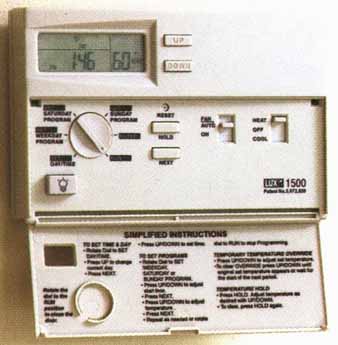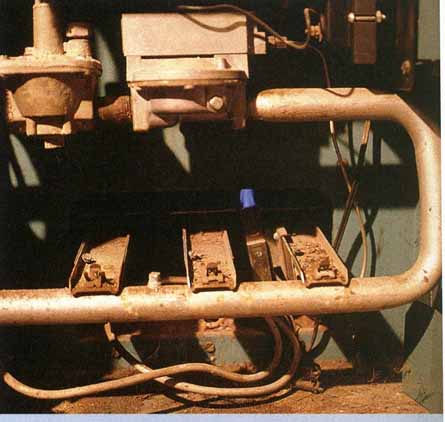In colder parts of the United States, heating is the biggest single energy
expense in most homes. In that case, saving on heating can make a big difference,
Aside from the building envelope, your heating system is probably the next
biggest factor in your energy use, so anything you can do to improve its operation
has the potential to save a lot of energy.
There are many kinds of heating systems (which will be covered later in this chapter), but they all have three common elements: a heating plant, which converts fuel into heat; a distribution system, which delivers heat around the house; and controls, which regulate the system’s operation. All have an impact on the efficiency of the system, and all can typically be improved to save energy.
Professional Tip: Turning down a thermostat overnight or when people are out does not mean using more energy to bring the house back up to temperature. More Specifically: One problem with setting back the thermostat at night (or while you’re away) is that the house is cold when you get up (or come home). If you have a fairly regular schedule, an automatic clock-thermostat can help. Program it to turn down the heat 30 minutes after bed time and turn up the heat just before you get up. Once it’s set, you don’t have to do anything. Most clock-thermostats can handle two or more setback periods during the day, and many have 7-day programs for weekends. Some have battery backup to retain the settings in case the power goes out. If you don’t like to program your VCR, try to avoid the fancy electronic models.
|
Thermostats
A thermostat is one control that is common to virtually every heating system. Thermostats sense the room temperature and turn the heating plant on when the temperature drops below the set point. The simplest thing you can do to save energy is to turn down the thermostat. Depending on the cli mate, you can save between 1% and 3% for every degree (Fahrenheit) colder that you keep the house.
Turning down a thermostat saves energy, but only if you’re consistent. If one person is always turning down the set point, and another is always turning it back up, you can actually use more energy, because the heating system cycles more than it would otherwise—particularly if the person who gets chilly sets the thermostat even higher than he or she otherwise would. This “dueling manager” syndrome is particularly bad if you have a heat pump. Find the lowest setting that everyone in the family is consistently comfortable with, and then leave it alone (other than for long- term setbacks of several hours or more).
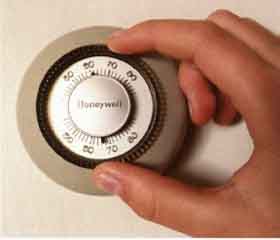
Turning down your thermostat can save significant energy,
but don’t turn it down to the point of discomfort.
Keep in mind that saving energy doesn’t mean shivering in the dark. Deprivation is not the best route to efficiency On the other hand, once you have insulated and air—sealed a house, and perhaps installed high-performance windows, you may find that you are perfectly comfortable at a lower thermostat setting. For example, one of my construction consulting clients built a new house just up the hill from the old Victorian farmhouse he and his wife owned. “One of the most amazing things,” he told me, “is the change in our thermo stat setting. The old house was so drafty that we had to set the thermostat at 72°F or more to stay comfortable. In this one, we get too warm if we set it above 64°F!”
Another way to save energy with your thermo stat is by using a regular setback, Turning down the house temperature for 6 or 8 hours while everyone is asleep, or away during the day can save a lot—close to 10% for an 8-hour, 10-degree setback. Contrary to popular belief, it does not take more energy to bring the house back up to temperature. Remember, your heating system’s only function is to replace heat that the house loses; if the indoor temperature is lower for a period of time, the house loses less heat during that period. When the thermostat goes back up, the long cycle while the heating system catches up is actually more efficient than the more typical, shorter cycles.
Comfort and energy use
Another fairly simple factor that affects heating— system performance is system balancing. Balancing refers to the temperature consistency from one room to the next. If one or more rooms are consistently too cold, people tend to set the thermostat high enough to be comfortable in those rooms. The rest of the house will then overheat, using more energy.
Balancing problems can be caused by thermal defects in the building, by problems in the heating distribution system, or by the thermostat location. Rooms that have air leaks, drafts, or missing insulation may lose heat faster than neighboring rooms, or they may just be uncomfortable. Thermal problems should be fixed before addressing the heating system. Once the building envelope is properly treated, the distribution system can usually be adjusted for better balance.
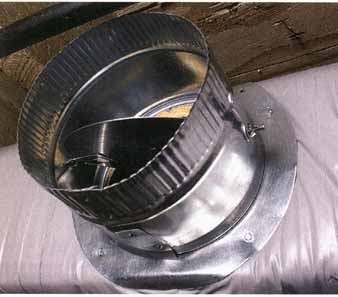
Furnaces or heat pumps that have a ducted distribu tion
system should have manual balancing dampers, like this one, near the takeoffs
from the main trunk duct to the branch runs. It is better to adjust the
airflow here than at the supply register (shown with duct disconnected
for clarity).
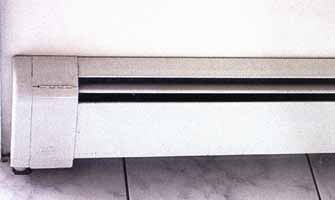
This is a typical hot water radiator, or fun-tube baseboard.
Like most fin-tube units, it has a hinged damper to close the slot at
the top of the unit and reduce heat output.
Efficiency Losses in a Furnace Not all the heat contained in the fuel you buy contributes to keeping your house warm. Furnace efficiency is the percentage of the heat that you buy (100%) that does useful work for you; anything less than 100% represents a wasted expense, or loss in efficiency. There are three kinds of furnace efficiency losses. Combustion efficiency, off-cycle losses, and distribution losses. Combustion efficiency is the percentage of the heat bought at the meter that is delivered by the furnace; it varies from 50% to 95%. Of the 5% to 50% of heat that’s lost, most is simply heat that goes up the chimney; other combustion losses include incomplete combustion (caused by burners that are dirty or out of tune) and heat that escapes through the cabinet. Off-cycle losses occur when the furnace starts and stops. Each time the furnace shuts off, some heat remains in the furnace; most of that heat goes up the chimney. If you have a standing gas pilot, most of the heat produced by the pilot is lost, particularly if the pilot is left burning all summer long. Distribution losses occur when heat that is generated by the furnace can’t get to where it’s needed. Distribution losses include duct air leaks, conductive losses through uninsulated ducts, and airflow problems. Other heating systems (boilers and heat pumps) have similar efficiency losses.
|
